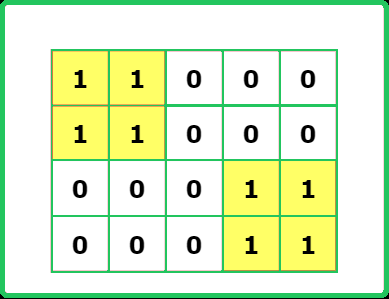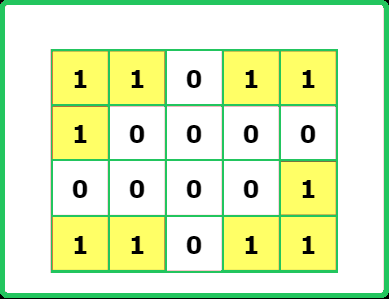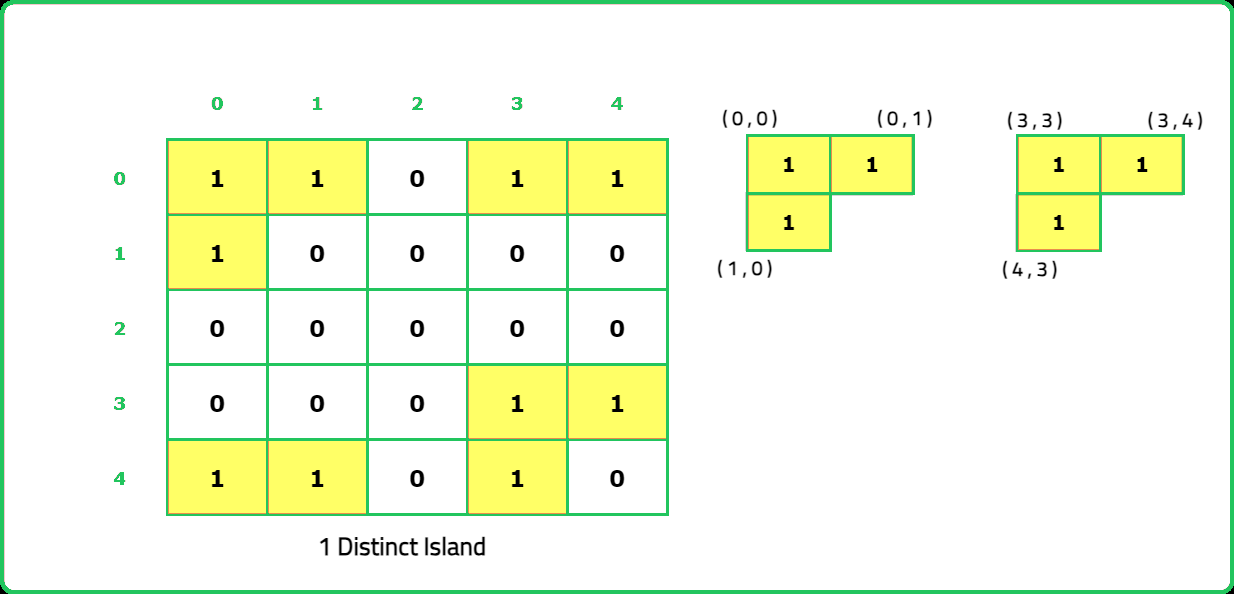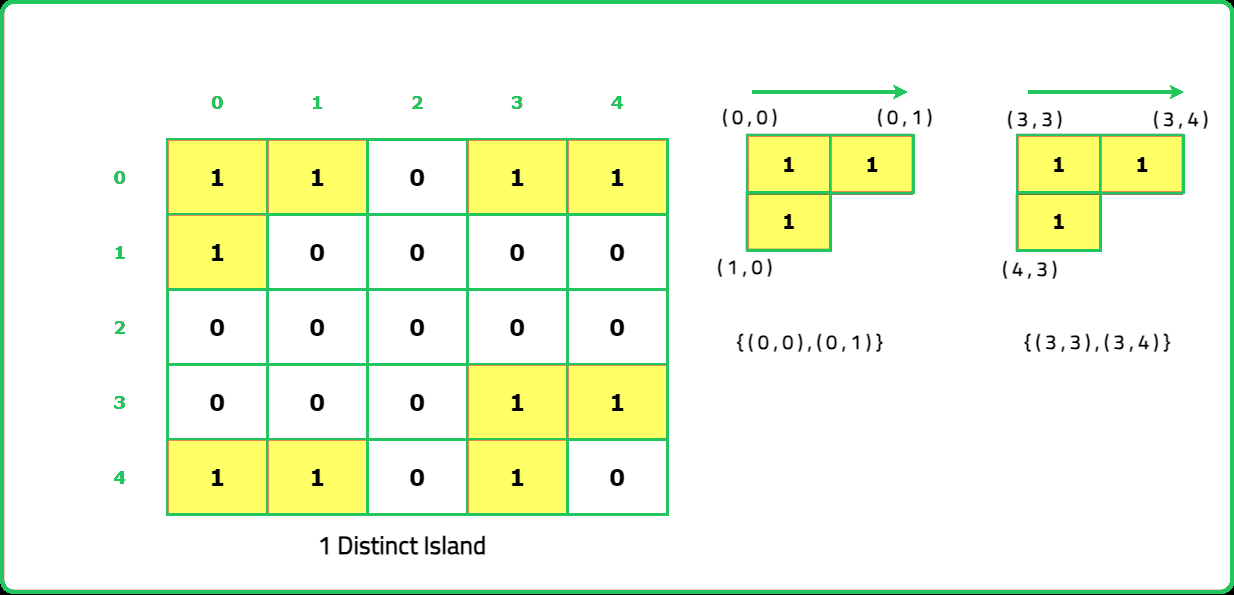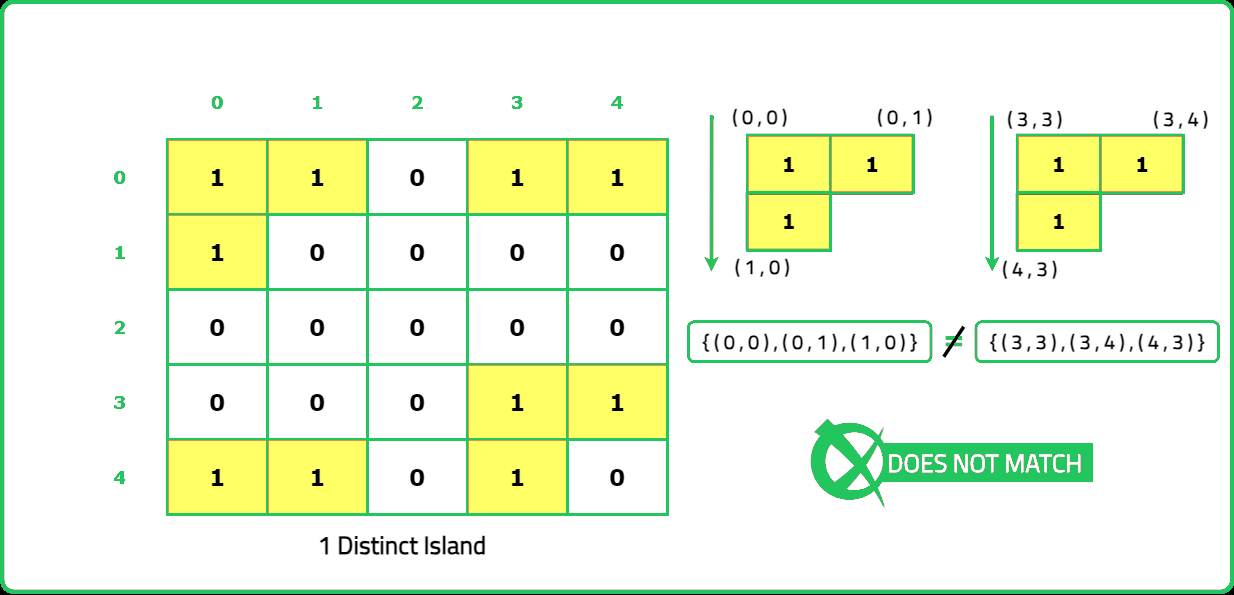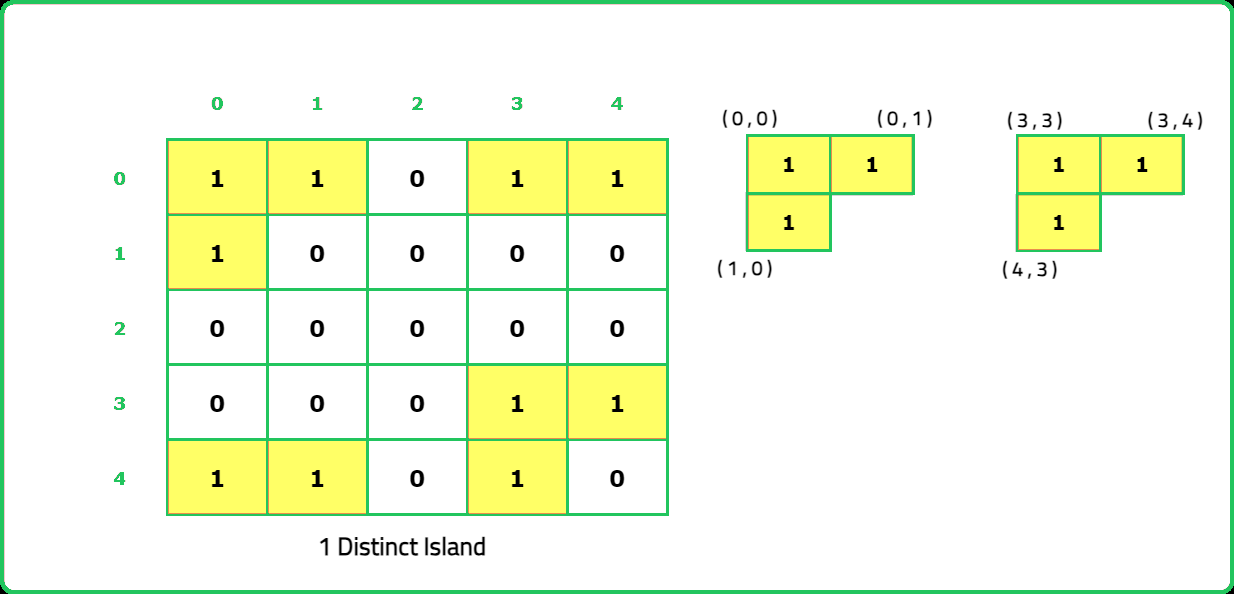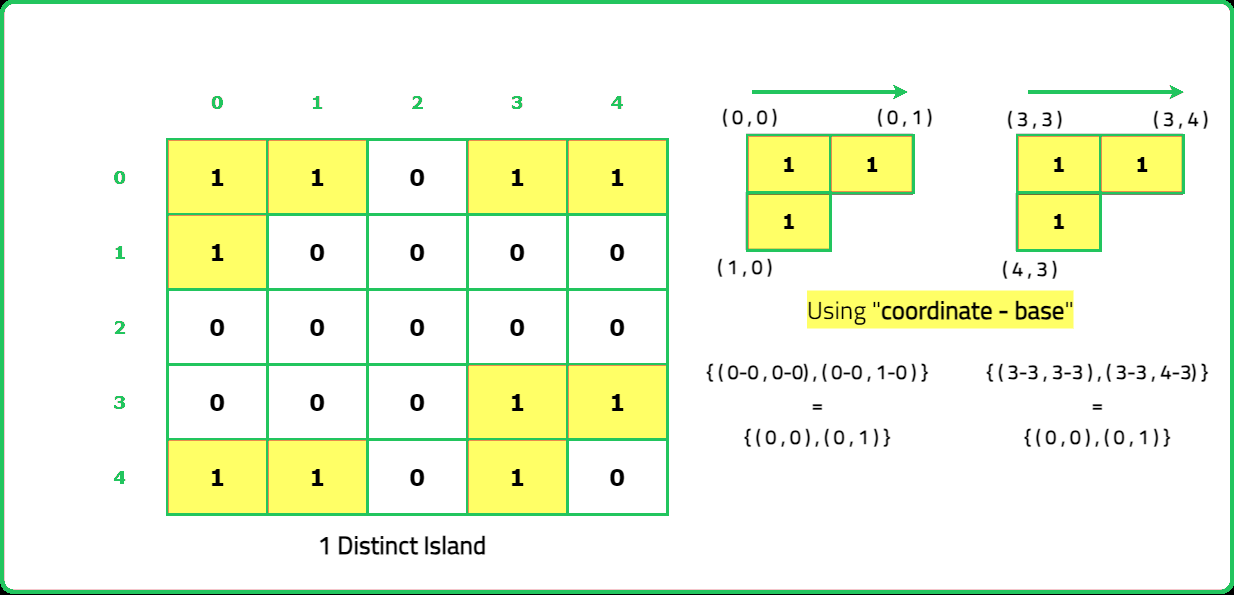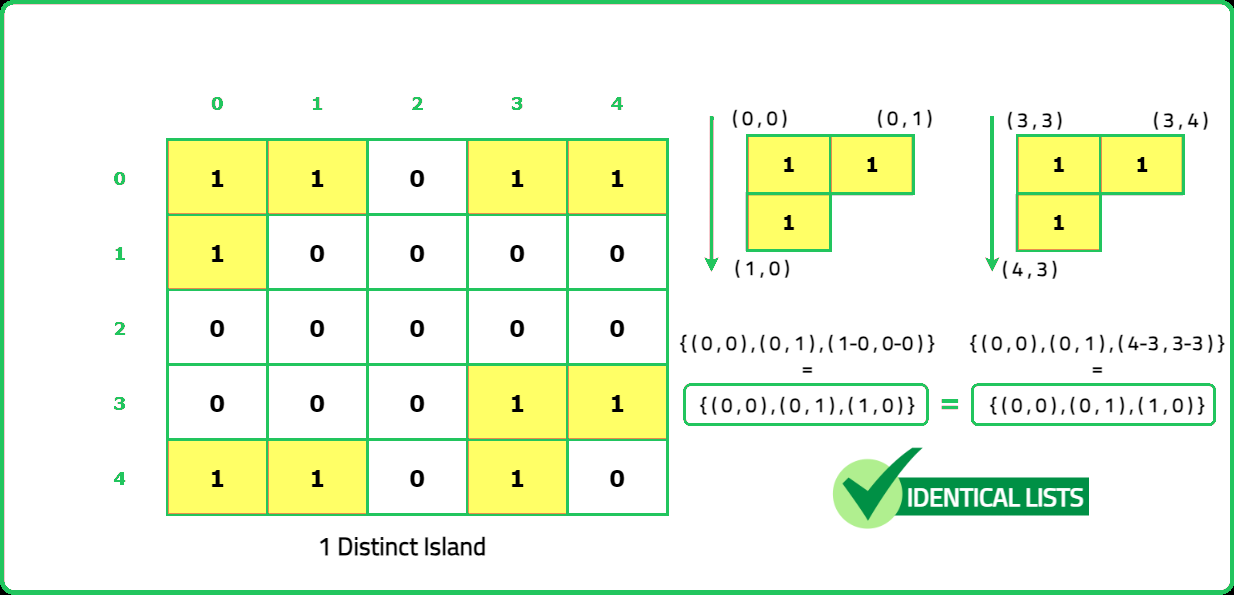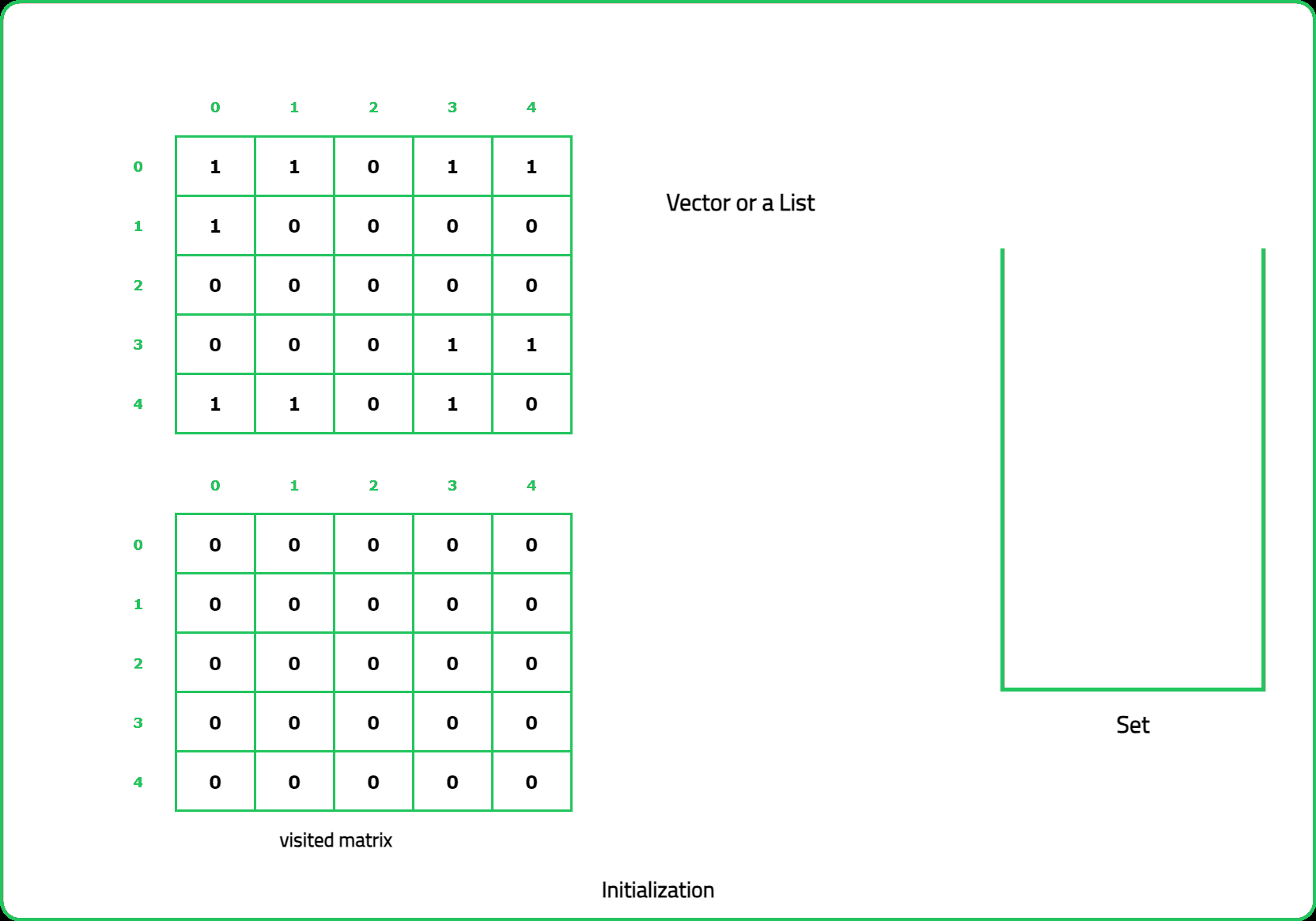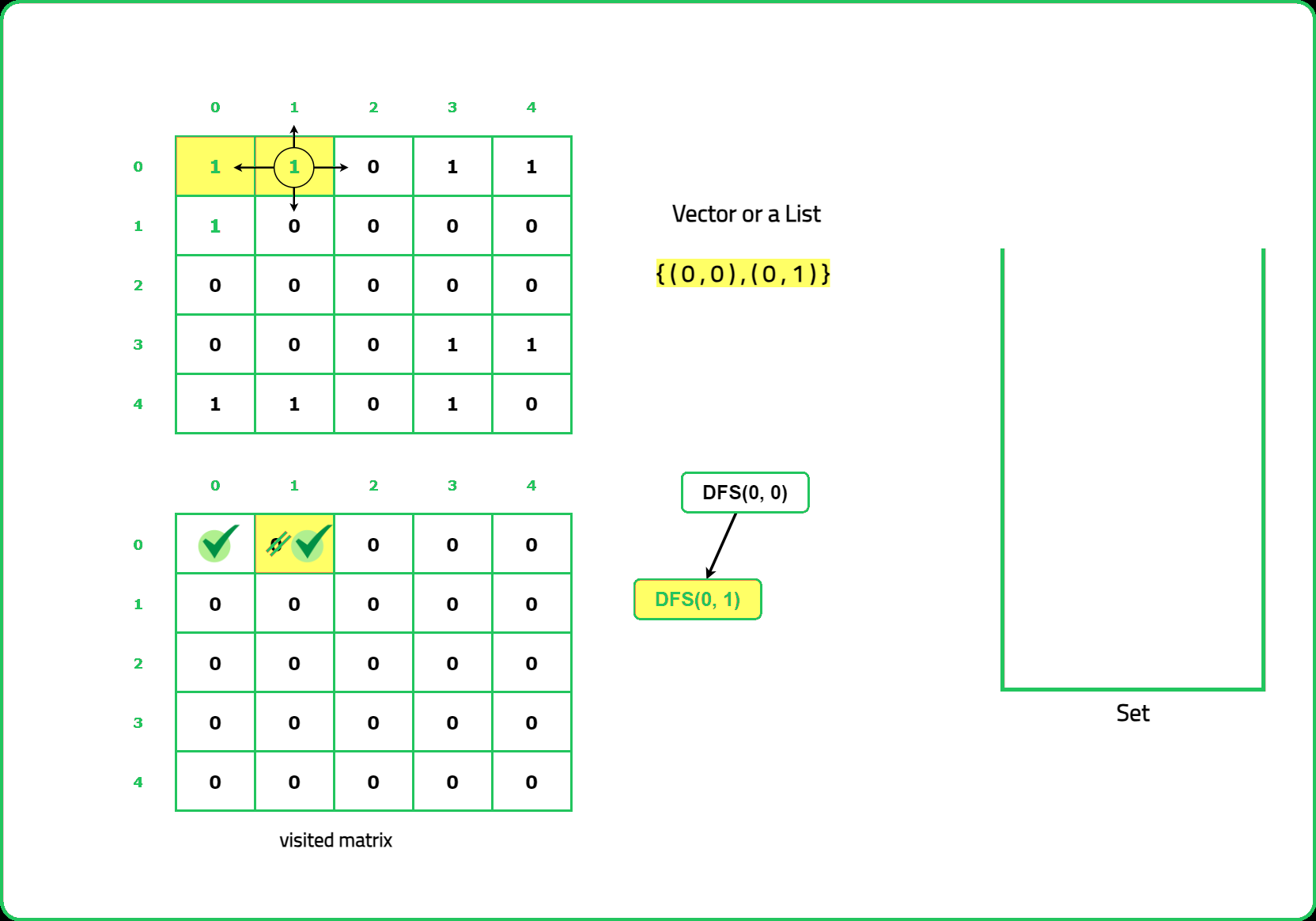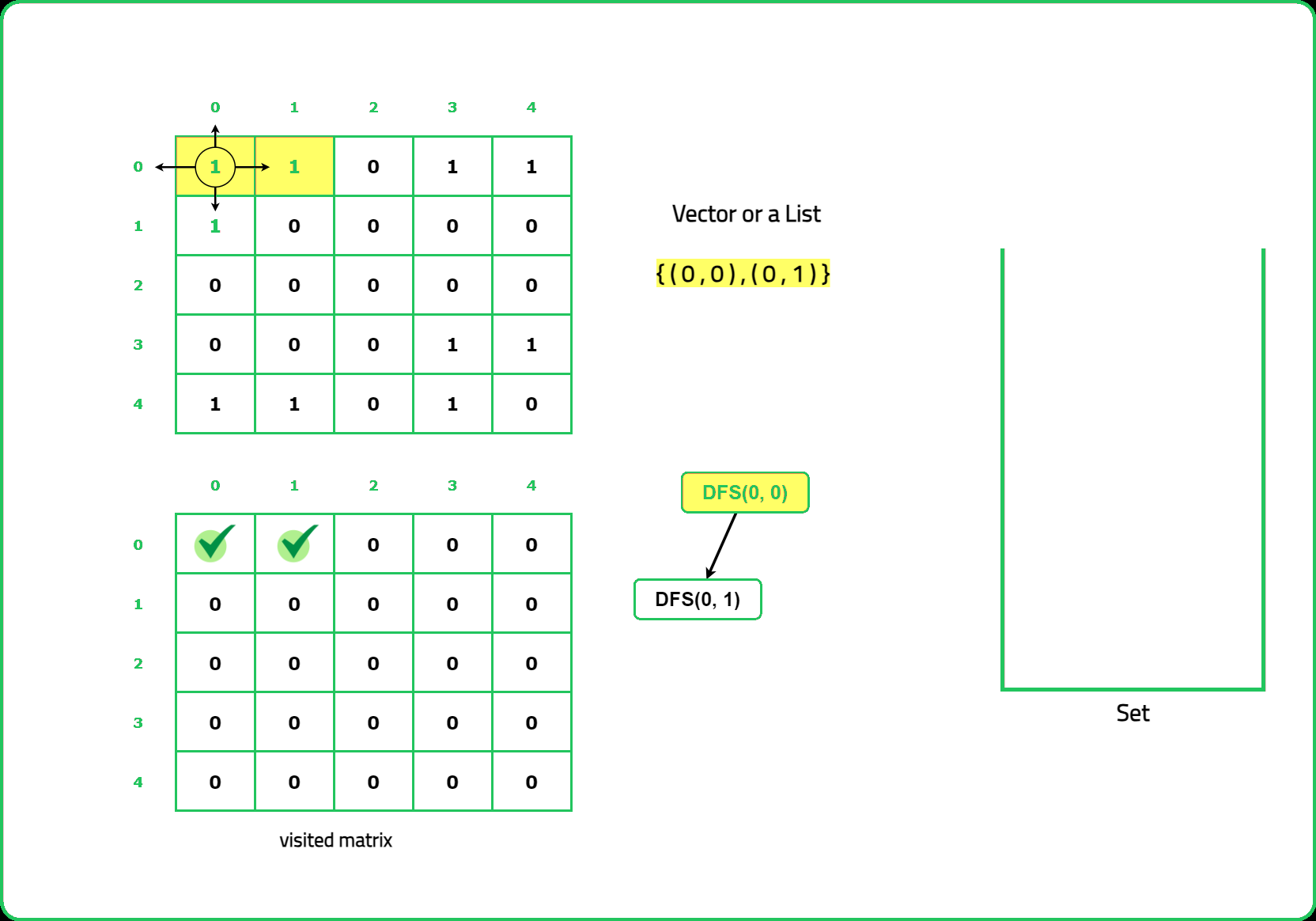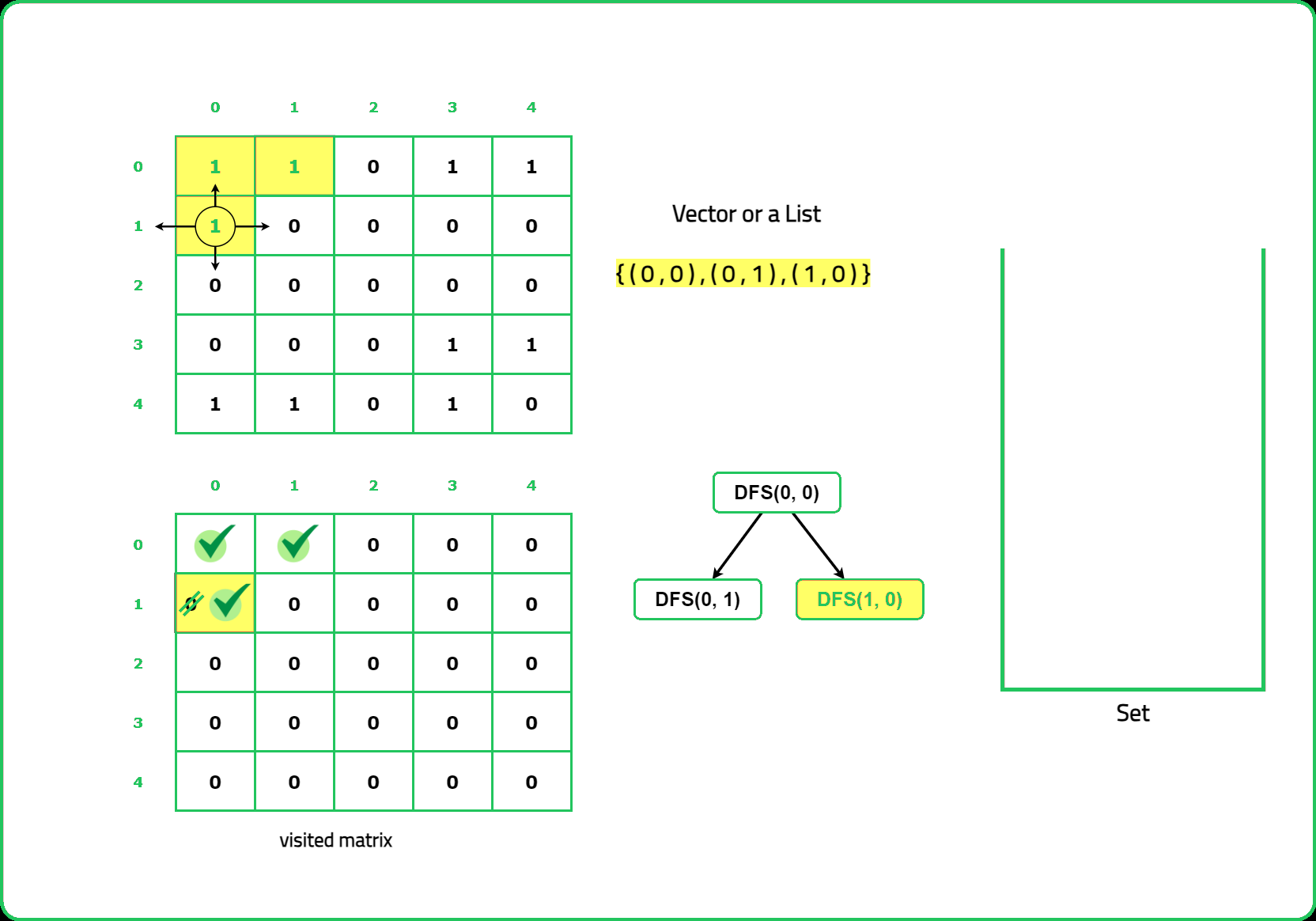123456789101112131415161718192021222324252627282930313233343536373839404142434445464748495051525354555657585960616263646566676869707172737475767778798081828384858687888990919293949596979899100101102103104105106107108109110111112113114115116117118119120121122123124125126
#include <bits/stdc++.h>
using namespace std;
class Solution {
private:
// DelRow and delCol for neighbors
vector<int> delRow = {-1, 0, 1, 0};
vector<int> delCol = {0, -1, 0, 1};
/* Helper function to check if a
cell is within boundaries */
bool isValid(int &i, int &j,
int &n, int &m) {
// Return false if cell is invalid
if(i < 0 || i >= n) return false;
if(j < 0 || j >= m) return false;
// Return true if cell is valid
return true;
}
// Function for DFS traversal of island
void dfs(int row, int col,
vector<vector<int>> &grid,
vector<vector<bool>> &visited,
vector<pair<int,int>> &path,
int &base_row, int &base_col) {
// Get the dimensions of grid
int n = grid.size();
int m = grid[0].size();
/* Add relative position of current
cell with respect to the base cell */
path.push_back({row-base_row, col-base_col});
// Traverse the 4 neighbors
for(int i=0; i<4; i++) {
// Get coordinates of new cell
int nRow = row + delRow[i];
int nCol = col + delCol[i];
// Traverse unvisited, valid, land cell
if(isValid(nRow, nCol, n, m) &&
grid[nRow][nCol] == 1 &&
!visited[nRow][nCol]) {
// Mark the cell as visited
visited[nRow][nCol] = true;
// Recursively call DFS for the new cell
dfs(nRow, nCol, grid, visited, path, base_row, base_col);
}
}
// Return after all neighbors are explored
return;
}
public:
/* Function to count the count of
distinct islands in the given grid */
int countDistinctIslands(vector<vector<int>>& grid) {
// Get the dimensions of grid
int n = grid.size();
int m = grid[0].size();
// 2-D Visited array
vector<vector<bool>> visited(n, vector<bool>(m, false));
// Set to store traversal of unique islands
set <vector <pair <int, int>>> st;
// Traverse the grid
for(int i=0; i<n; i++) {
for(int j=0; j<m; j++) {
/* Start BFS traversal if an
unvisited land cell is found */
if(grid[i][j] == 1 && !visited[i][j]) {
// Mark the cell as visited
visited[i][j] = true;
// To store the path of cells
vector<pair<int,int>> path;
// Start DFS traversal from the cell
dfs(i, j, grid, visited, path, i, j);
// Add the path of explored island to the set
st.insert(path);
}
}
}
return st.size();
}
};
int main() {
vector<vector<int>> grid = {
{1, 1, 0, 1, 1},
{1, 0, 0, 0, 0},
{0, 0, 0, 0, 1},
{1, 1, 0, 1, 1}
};
/* Creating an instance of
Solution class */
Solution sol;
/* Function to count the count of
distinct islands in the given grid */
int ans = sol.countDistinctIslands(grid);
// Output
cout << "The count of distinct islands in the given grid is: " << ans << endl;
return 0;
}
123456789101112131415161718192021222324252627282930313233343536373839404142434445464748495051525354555657585960616263646566676869707172737475767778798081828384858687888990919293949596979899100101102103104105
import java.util.*;
class Solution {
// DelRow and delCol for neighbors
private int[] delRow = {-1, 0, 1, 0};
private int[] delCol = {0, -1, 0, 1};
/* Helper function to check if a
cell is within boundaries */
private boolean isValid(int i, int j, int n, int m) {
// Return false if cell is invalid
if (i < 0 || i >= n) return false;
if (j < 0 || j >= m) return false;
// Return true if cell is valid
return true;
}
// Function for DFS traversal of island
private void dfs(int row, int col, int[][] grid, boolean[][] visited,
List<String> path, int baseRow, int baseCol) {
// Get the dimensions of grid
int n = grid.length;
int m = grid[0].length;
/* Add relative position "row,col" of current
cell with respect to the base cell */
path.add((row - baseRow) + "," + (col - baseCol));
// Traverse the 4 neighbors
for (int i = 0; i < 4; i++) {
// Get coordinates of new cell
int nRow = row + delRow[i];
int nCol = col + delCol[i];
// Traverse unvisited, valid, land cell
if (isValid(nRow, nCol, n, m) && grid[nRow][nCol] == 1 && !visited[nRow][nCol]) {
// Mark the cell as visited
visited[nRow][nCol] = true;
// Recursively call DFS for the new cell
dfs(nRow, nCol, grid, visited, path, baseRow, baseCol);
}
}
}
/* Function to count the number of
distinct islands in the given grid */
public int countDistinctIslands(int[][] grid) {
// Get the dimensions of grid
int n = grid.length;
int m = grid[0].length;
// 2-D Visited array
boolean[][] visited = new boolean[n][m];
// Set to store traversal of unique islands
Set<List<String>> st = new HashSet<>();
// Traverse the grid
for (int i = 0; i < n; i++) {
for (int j = 0; j < m; j++) {
/* Start DFS traversal if an
unvisited land cell is found */
if (grid[i][j] == 1 && !visited[i][j]) {
// Mark the cell as visited
visited[i][j] = true;
// To store the path of cells
List<String> path = new ArrayList<>();
// Start DFS traversal from the cell
dfs(i, j, grid, visited, path, i, j);
// Add the path of explored island to the set
st.add(path);
}
}
}
return st.size();
}
}
class Main {
public static void main(String[] args) {
int[][] grid = {
{1, 1, 0, 1, 1},
{1, 0, 0, 0, 0},
{0, 0, 0, 0, 1},
{1, 1, 0, 1, 1}
};
/* Creating an instance of
Solution class */
Solution sol = new Solution();
/* Function to count the number of
distinct islands in the given grid */
int ans = sol.countDistinctIslands(grid);
// Output
System.out.println("The count of distinct islands in the given grid is: " + ans);
}
}
123456789101112131415161718192021222324252627282930313233343536373839404142434445464748495051525354555657585960616263646566676869707172737475767778798081828384858687888990919293949596979899100101
from typing import List
class Solution:
# DelRow and delCol for neighbors
delRow = [-1, 0, 1, 0]
delCol = [0, -1, 0, 1]
# Helper function to check if a
# cell is within boundaries
def isValid(self, i, j, n, m):
# Return false if cell is invalid
if i < 0 or i >= n: return False
if j < 0 or j >= m: return False
# Return true if cell is valid
return True
# Function for DFS traversal of island
def dfs(self, row, col, grid, visited,
path, base_row, base_col):
# Get the dimensions of grid
n = len(grid)
m = len(grid[0])
# add relative position of current
# cell with respect to the base cell
path.append((row-base_row, col-base_col))
# Traverse the 4 neighbors
for i in range(4):
# Get coordinates of new cell
nRow = row + self.delRow[i]
nCol = col + self.delCol[i]
# Traverse unvisited, valid, land cell
if (self.isValid(nRow, nCol, n, m) and
grid[nRow][nCol] == 1 and
not visited[nRow][nCol]):
# Mark the cell as visited
visited[nRow][nCol] = True
# Recursively call DFS for the new cell
self.dfs(nRow, nCol, grid, visited,
path, base_row, base_col)
# Return after all neighbors are explored
return
# Function to count the count of
# distinct islands in the given grid
def countDistinctIslands(self, grid: List[List[int]]) -> int:
# Get the dimensions of grid
n = len(grid)
m = len(grid[0])
# 2-D Visited array
visited = [[False for _ in range(m)] for _ in range(n)]
# Set to store traversal of unique islands
st = set()
# Traverse the grid
for i in range(n):
for j in range(m):
# Start BFS traversal if an
# unvisited land cell is found
if grid[i][j] == 1 and not visited[i][j]:
# Mark the cell as visited
visited[i][j] = True
# To store the path of cells
path = []
# Start DFS traversal from the cell
self.dfs(i, j, grid, visited, path, i, j)
# Add the path of explored island to the set
st.add(tuple(path))
return len(st)
# Example usage
grid = [
[1, 1, 0, 1, 1],
[1, 0, 0, 0, 0],
[0, 0, 0, 0, 1],
[1, 1, 0, 1, 1]
]
# Creating an instance of Solution class
sol = Solution()
# Function to count the count of distinct islands in the given grid
ans = sol.countDistinctIslands(grid)
# Output
print("The count of distinct islands in the given grid is:", ans)
1234567891011121314151617181920212223242526272829303132333435363738394041424344454647484950515253545556575859606162636465666768697071727374757677787980818283848586878889909192939495969798
class Solution {
constructor() {
// DelRow and delCol for neighbors
this.delRow = [-1, 0, 1, 0];
this.delCol = [0, -1, 0, 1];
}
/* Helper function to check if a
cell is within boundaries */
isValid(i, j, n, m) {
// Return false if cell is invalid
if (i < 0 || i >= n) return false;
if (j < 0 || j >= m) return false;
// Return true if cell is valid
return true;
}
// Function for DFS traversal of island
dfs(row, col, grid, visited, path, base_row, base_col) {
// Get the dimensions of grid
const n = grid.length;
const m = grid[0].length;
// add relative position of current
// cell with respect to the base cell
path.push([row - base_row, col - base_col]);
// Traverse the 4 neighbors
for (let i = 0; i < 4; i++) {
// Get coordinates of new cell
const nRow = row + this.delRow[i];
const nCol = col + this.delCol[i];
// Traverse unvisited, valid, land cell
if (this.isValid(nRow, nCol, n, m) && grid[nRow][nCol] === 1 && !visited[nRow][nCol]) {
// Mark the cell as visited
visited[nRow][nCol] = true;
// Recursively call DFS for the new cell
this.dfs(nRow, nCol, grid, visited, path, base_row, base_col);
}
}
// Return after all neighbors are explored
return;
}
/* Function to count the count of
distinct islands in the given grid */
countDistinctIslands(grid) {
// Get the dimensions of grid
const n = grid.length;
const m = grid[0].length;
// 2-D Visited array
const visited = Array.from({ length: n }, () => Array(m).fill(false));
// Set to store traversal of unique islands
const st = new Set();
// Traverse the grid
for (let i = 0; i < n; i++) {
for (let j = 0; j < m; j++) {
// Start BFS traversal if an
// unvisited land cell is found
if (grid[i][j] === 1 && !visited[i][j]) {
// Mark the cell as visited
visited[i][j] = true;
// To store the path of cells
const path = [];
// Start DFS traversal from the cell
this.dfs(i, j, grid, visited, path, i, j);
// Add the path of explored island to the set
st.add(JSON.stringify(path));
}
}
}
return st.size;
}
}
// Example usage
const grid = [
[1, 1, 0, 1, 1],
[1, 0, 0, 0, 0],
[0, 0, 0, 0, 1],
[1, 1, 0, 1, 1]
];
// Creating an instance of Solution class
const sol = new Solution();
// Function to count the count of distinct islands in the given grid
const ans = sol.countDistinctIslands(grid);
// Output
console.log("The count of distinct islands in the given grid is:", ans);
